Energy structure of the accelerated H2O ions above 1 KeV: the comet 67P/Churyumov-Gerasimenko observed by the Rosetta spacecraft
- 1Graduate School of Science, Kyoto University, Kyoto, Japan (kotani@kugi.kyoto-u.ac.jp)
- 2Swedish Institute of Space Physics, Kiruna, Sweden
- 3ESTEC, European Space Agency, Noordwijk, The Netherlands
Introduction
The Plasma Consortium Ion Composition Analyzer (RPC/ICA) onboard ESA's Rosetta mission has revealed that comet-origin water ions are accelerated in a more complicated manner than previously thought[1]. Understanding these acceleration mechanisms in a cometary environment is an important issue in both cometary science and plasma physics. Very close to the comet, ambipolar diffusion accelerates newly ionized (by solar Extreme-UV (EUV) radiation, electron impact ionization, or charge-exchange) outgassing water molecules from the comet. If moderately far from the comet where solar winds can access, water ions are picked up by the solar wind and accelerated by the solar wind electric field[1].
However, water ions are also accelerated in the magnetosphere, where solar wind ions cannot intrude and background neutrals may play some role. The acceleration mechanism there is not fully understood due to an unknown electric field environment. One common characteristic as observed by ICA near in the comet 67P/Churyumov-Gerasimenko is energy-angle dispersion when the acceleration is > 100 eV[2,3]. If the acceleration is > 300 eV (particularly > 1 keV), we found that dispersion becomes reversed for almost all cases. In our presentation, we show two typical types of energy-angle dispersions. We also discuss a possible acceleration mechanism.
Instrument
RPC-ICA measures the distribution function of positively charged ions with mass-separation capability, has a field of view (FOV) of 360° with 22.5° resolution in azimuthal angle, and scanning 90° in the elevation direction over 192 sec with ~ 5° resolution for each elevation scan. To survey all the comet-rendezvous data from 2014 August to 2016 September, we used one-hour quick-look (QL) data as shown in Figure 1 and Figure 3. The magnetometer RPC-MAG measures the three components of the magnetic field, with an accuracy of ~ ±3 nT per component.
Observation
1. Nose-dispersion: Figure 1 shows the energy-time, energy-angle, and energy-mass spectrograms of positively charged ions from 7 December 2015, 23:00-24:00 UTC. In Figure 1, the direction of the energy-elevation dispersions is reversed between above 500 eV and below 200 eV, making the entire pattern nose-like. This pattern is also seen in the integrated energy-elevation spectrograms in Figure 1b. Figure 1c indicates that they are heavy ions whereas the solar wind ions (H+, He2+, He+) are not observed. The energy of the "nose", where the direction of dispersion reversed, is about 300-500 eV. We find 68 events (in terms of 1-hour QL data) for this type of dispersion with maximum energy > 1 keV out of 12268 hours QL data during 2 years.
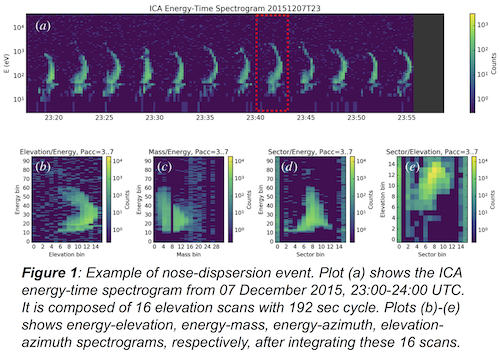
Next, we investigate where water ions come from with respect to the directions of the sun, the comet, and the magnetic field. We note that, although high-energy water ions (> 200 eV) are dispersed in the elevation plane, lower energy water ions (< 200 eV) are spread wider in the azimuthal direction than higher energy ions as shown in Figure 1d. Still, Figure 2 shows that the H2O+ flow direction is close to the magnetic field direction, and the pitch-angles are larger at mid energy than low and high energies, causing the nose-dispersion as illustrated in Figure 5, in addition to different (and limited) gyrophase angles for different energy.
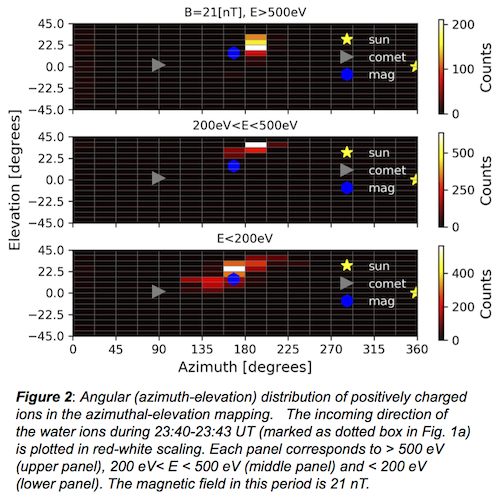
2. Sharp-dispersion:
In Figures 3 and 4, we show another type of dispersion event with maximum energy > 1 keV. In this example, water ions are dispersed more "sharply" in the elevation plane. The maximum energy exceeds 1 keV, and the energy where these "sharp dispersion" events seem to be reversed is also about 100-300 eV. We find 51 events during 2 years of observation (see, Table 1). Figure 4 indicates that higher energy water ions (>300 eV) are dispersed in the elevation plane and lower energy water ions are spread widely in the azimuthal direction, which is in good agreement with the nose-like events. However, higher energy water ions come from the direction quasi-perpendicular to the magnetic field and lower energy water ions come from the nucleus of the comet along magnetic field. This means that sharp-like dispersion occurs separately in different energy ranges in the example.
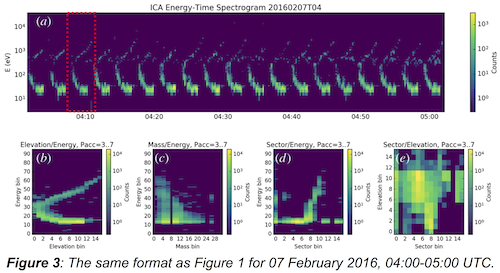
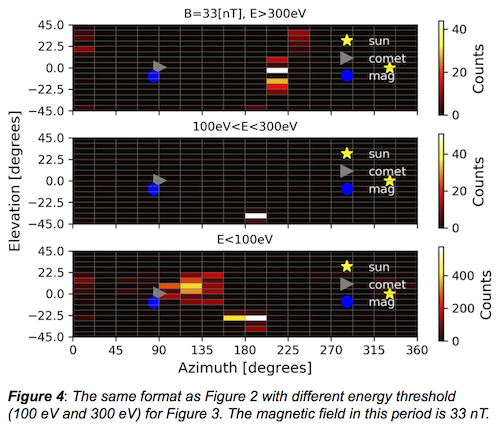
Interpretation
In previous studies where acceleration of water ions < several hundred eV is reported, dispersion direction is not reversed and therefore we could interpret it as acceleration by the electric field that is simply a transition from the solar wind electric field and the polarization (ambipolar type) electric fields[2, 4]. The sharp-dispersion event can be understood along this view, i.e., low energy water ions ( < several hundred eV) are accelerated along the magnetic field by the ambipolar electric field and the high energy water ions might be accelerated quasi-perpendicular to the magnetic field by the solar wind electric field. However, these electric fields are not enough to explain nose-like reversed dispersion. To explain the reversal of the dispersion direction, just magnetic curvature in not sufficient as illustrated in Figure 5a. In this configuration, we can explain the dispersion at lower energy with respect to pitch angle, but not the high energy part simultaneously. This means that we need more complicated non-uniformness in the magnetic field configuration. We must also note that gyroradius of 1 keV H2O with 20° pitch angles under 20 nT magnetic field is about 300 km (cf. Rosetta-comet distance is about 100 km) when considering such non-uniformity.
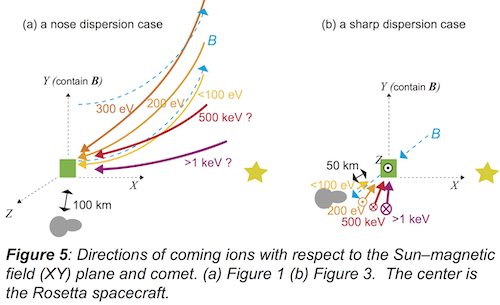
References
How to cite: Kotani, T., Yamauchi, M., Nilsson, H., Stenberg-Wieser, G., Wieser, M., Bergman, S., Taguchi, S., and Götz, C.: Energy structure of the accelerated H2O ions above 1 KeV: the comet 67P/Churyumov-Gerasimenko observed by the Rosetta spacecraft, Europlanet Science Congress 2020, online, 21 Sep–9 Oct 2020, EPSC2020-576, https://doi.org/10.5194/epsc2020-576, 2020.

